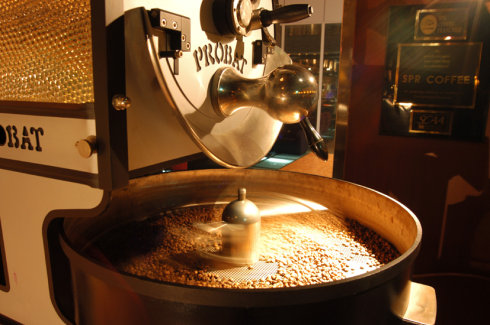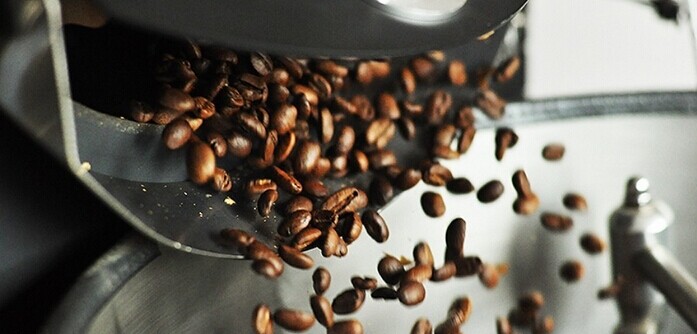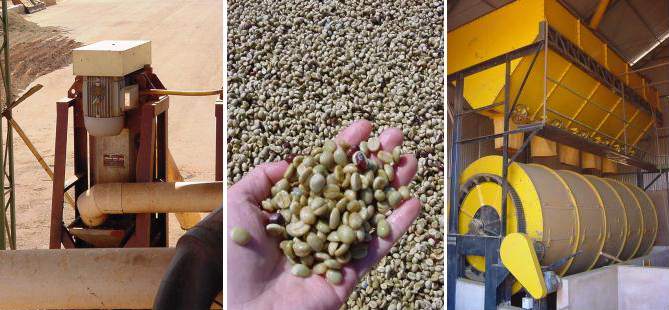Introduction to Coffee-basic knowledge of roasting
Raw coffee beans themselves do not have any aroma of coffee, only after fried, can you smell the strong aroma of coffee. So the roasting of coffee beans is the transformation process of the internal components of coffee beans, only after roasting to produce ingredients that can release the aroma of coffee, we can smell the aroma of coffee. But in the roasting process of coffee beans, the transformation of ingredients is very complex, after all, coffee beans are organic matter, so the transformation of this component is very complex, and the modern knowledge of organic chemistry can not fully understand.
However, the roasting of coffee beans directly determines the aroma of coffee beans. If the coffee is not roasted well, even if the raw coffee beans are very good, you can't get good ripe coffee beans; as a result, you can't make good coffee. Only with good coffee raw beans, after proper roasting, it is possible to process good coffee cooked beans, and it is also possible to provide a good prerequisite for making good coffee.
Fried coffee beans are roasted at high temperatures, or roasted, to create the coffee's unique color (similar to amber, depending on the degree of roasting), flavor and aroma. Frying turns the green (or yellowish) raw coffee beans into the familiar tea-brown coffee beans. High-quality fried roasting refers to the ingenious expression of the aroma, sour and bitter ingredients of raw coffee beans.
A series of chemical changes occur in the process of baking. After about 5-25 minutes of baking (depending on the temperature selected), the green coffee beans lose some humidity and turn yellow. In this process, the coffee beans will swell, changing from a strong, high-density raw bean to a low-density fluffy state. After this process, the coffee beans will about double in size and begin to show a light brown after stir-frying. After this stage is completed (after about 8 minutes of baking), the calories will be reduced. The color of the coffee soon changed to dark. When the preset baking depth is reached, cold air can be used to cool the coffee beans in order to stop the baking process.

Baking is roughly divided into shallow baking (Light), medium baking (Medium), urban baking (City) and deep baking (Deep).
Light roasted coffee beans: will have a strong smell, very crisp, high acidity is the main flavor and slightly mellow. Medium-roasted coffee beans: have a strong mellow, but also retain a certain degree of acidity.
City-baked coffee beans: the surface is dark brown, the acidity is replaced by slight bitterness, and most of the flavor has been destroyed.
Deep-roasted coffee beans: dark brown in color and oily on the surface. For most coffee beans, the alcohol content increases significantly and the acidity decreases.
In fact, roasting coffee is a way of processing food. The roasting of professional coffee is the personal expression of the roaster. The biggest problem when you first come into contact with professional coffee beans with different roasting degrees (SPCIAITYCOFFEE) is the name of the roasting degree. For example, CITY, FUIICITY, FRENCH, ESPRESSO, etc., all produce different baking colors because of the different baking machines and producing areas. In addition, some roasting levels are named after mixed coffee: for example, ESPRESSO is a coffee with a specific roasting degree for making ESPRESSO, and even if the color looks the same, it may have a completely different flavor. Therefore, the selection of the type of beans, baking temperature and baking method, and the length of baking time are the main factors that determine the final flavor.
The roasting method of professional coffee is usually divided into the following eight stages:
1. Very shallow baking (LIGHTRoast):
The degree of baking; very shallow baking, also known as shallow baking.
The lightest roasting degree of all roasting stages, the surface of the coffee beans is a light cinnamon color, its taste and aroma are insufficient, this state is almost undrinkable. It is generally used for testing and seldom for tasting.
2. Shallow baking (CINNAMONRoast):
Degree of baking; shallow baking, also known as cinnamon baking.
The general baking degree, showing cinnamon color on the appearance, the smell of green has been removed, the aroma is OK, and the acidity is strong, which is a common roasting degree of American coffee.
3. Micro baking (MEDIUMRoast):
Baking degree; moderate baking, also known as micro baking.
Medium baking heat and light baking are both American, in addition to sour taste, bitterness also appears, the taste is good. It has moderate aroma, acidity and mellowness, and is often used in the baking of mixed coffee.
4. Medium baking (HIGHRoast):
Baking degree; moderate micro-deep baking, also known as concentration baking.
Belongs to the moderate micro-deep baking, the baking degree is slightly stronger than the slight medium baking, the surface has appeared a little thick brown, the bitterness also becomes stronger. Coffee tastes sour and bitter, with good aroma and flavor, and is most often loved by people in Japan and Central Europe. (blue Mountain Coffee)
5. Medium and deep baking (CITYRoast):
Baking degree; medium-deep baking, also known as urban baking.
The most standard degree of roasting, bitterness and acidity are balanced and are often used in French coffee. (Brazil, Colombia)
6. Deep baking (FULL-CITYRoast):
Baking degree; micro-depth baking, also known as deep city baking.
The baking degree is slightly stronger than the medium depth, the color becomes quite dark, and the bitter taste is stronger than the sour taste. It belongs to the Central and South American baking method, which is very suitable for preparing all kinds of iced coffee.
7. Very Deep Baking (FrenchRoast):
Degree of baking; deep baking, also known as French baking.
Also known as French or European baking, belongs to deep baking, the color is thick brown with black, sour taste can not be felt, especially in Europe, France is the most popular, because the fat has infiltrated to the surface, with a unique flavor, very suitable for coffee Oulei, Viennese coffee.
8. Very Deep Baking (ItalianRoast):
Degree of baking; very deep baking, also known as Italian baking.
Also known as Italian baking, baking degree before carbonization, there is a scorched taste, mainly popular in Latin countries, suitable for fast coffee and cappuccino. Most of them are used in Espresso coffee series.

Baking depth meter
Baking depth appearance baking stage (the following temperature data are for reference only because of the different positions of temperature control points in different roasters)
Very shallow baking LIGHT
Light brown
Before and after the first explosion, 195 to 205 degrees
Shallow baking CINNAMON
Yellowish brown
The first explosion is over, about 205 degrees.
Medium baking / micro baking MEDIUM
Brown
About 205 to 215 degrees
Medium and deep baking / city baking, CITY
Reddish brown
About 215 to 225 degrees
City-wide baking, FULLCITY
Dark brown * dotted oil
About 225 degrees 230 degrees before the start of the second explosion
French baked French
Dark brown * oily on the surface
About 230 to 235 degrees
Italian baking is deep baking, Italian
Close to the black surface and greasy
Above 240 degrees
The roasting of coffee beans is the most basic for students.
Important Notice :
前街咖啡 FrontStreet Coffee has moved to new addredd:
FrontStreet Coffee Address: 315,Donghua East Road,GuangZhou
Tel:020 38364473
- Prev

What are the basic treatment methods of coffee fruit?
There are a pair of oval seeds in the center of the fruit of the coffee tree, which are covered with exocarp, endocarp and pulp. Ripe fruits FB in a short period of time without treatment, so the purpose of refining is to enable coffee beans to be preserved for a long time, easy to store and circulate. After the fresh coffee fruit is harvested, it should be dealt with immediately. Refining is to remove the skin and pulp of the coffee fruit, and then take out the seeds.
- Next

The three elements of making a good cup of coffee-a good barista must see
There are many factors that affect the taste of coffee, a variety of subtle changes will have an impact on the taste of coffee, such as weather changes, etc., not to mention the small, from a big point of view: raw beans account for 60% of the factors that determine the taste of coffee, roasting accounts for 30%, and extraction accounts for 10%. 1 = 1. The influence of raw beans on coffee there are mainly Robusta and Arabica coffee beans in circulation on the market.
Related
- What is the meaning of lactic acid fermentation with coffee bean treatment?
- How to judge the state of foam by sound?
- How does the latte pull out the unicorn pattern? Come to get for a little trick to improve the flower pull!
- Will flower pulling affect the taste of the latte?
- Do you know the history of coffee?
- The difference between honey treatment and sun washing what is raisin honey treatment?
- What kind of milk can a novice use to make coffee foam to keep the foam longer? The correct method and skills of milking tutorial sharing
- Why do washed coffee beans taste sour? Flavor characteristics of washed Coffee
- Introduction to the skill of how to practice the size and height of water injection around the circle of hand-brewed coffee
- How do beginners practice coffee flower drawing from scratch?

